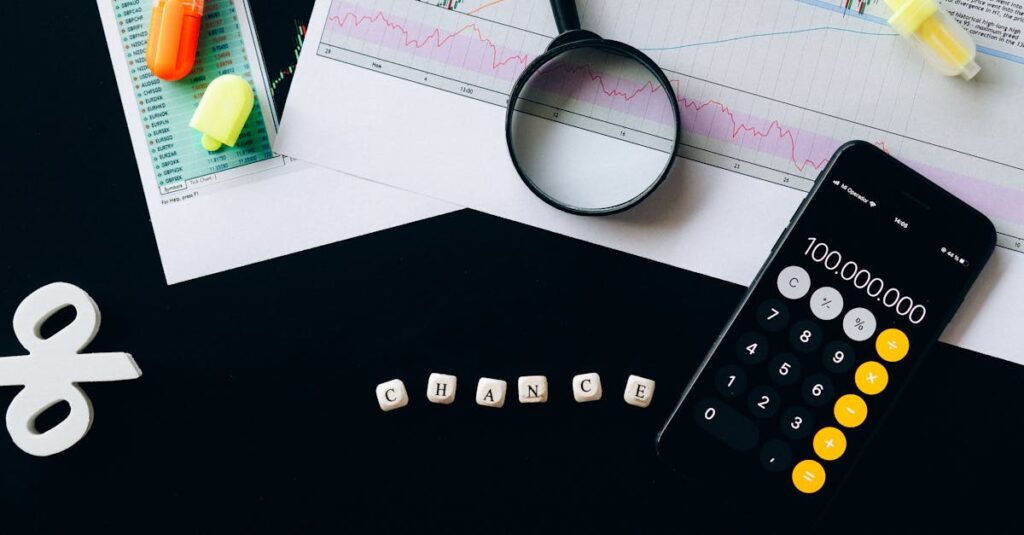Imagine if you could peek into the future of your finances, spotting trends before they happen and making smarter decisions with ease. Sounds like something out of a sci-fi movie, right? But with AI-driven financial trend analysis, this is quickly becoming a reality.
AI isn’t just crunching numbers—it’s uncovering patterns, forecasting market shifts, and giving you insights that once took teams of experts weeks to find. Whether you’re planning investments or simply trying to manage your budget, this cutting-edge technology has the potential to transform how you navigate your financial journey. Ready to see what the future of your money looks like? Let’s immerse.
Table of Contents
- 1 What Is AI Financial Trend Analysis?
- 2 How AI Is Revolutionizing Financial Trend Analysis
- 3 Benefits Of Using AI For Financial Predictions
- 4 Challenges And Limitations Of AI In Financial Trend Analysis
- 5 Real-World Examples Of AI Financial Trend Analysis In Action
- 6 Future Implications Of AI In Financial Markets
- 7 Conclusion
- 8 Frequently Asked Questions
- 8.1 What is AI financial trend analysis?
- 8.2 How does AI improve investment forecasting?
- 8.3 What are the benefits of using AI for financial predictions?
- 8.4 Can AI predict market crashes or black swan events?
- 8.5 What platforms use AI for financial analysis?
- 8.6 Is AI reliable for financial risk assessment?
- 8.7 What are the challenges of using AI in financial applications?
- 8.8 How can investors address ethical concerns around AI in finance?
- 8.9 Does AI replace the need for financial experts?
- 8.10 Can AI help small businesses with financial planning?
What Is AI Financial Trend Analysis?
AI financial trend analysis uses advanced algorithms to identify and interpret economic patterns, generating actionable insights. It analyzes data from diverse sources, including financial reports, stock market trends, and consumer spending behaviors, to project future market conditions and individual financial trajectories.
This process leverages machine learning and natural language processing to detect anomalies, correlations, and seasonality in financial data. Applications include predicting stock performance, analyzing economic risks, and optimizing investment strategies. For instance, AI may forecast a downturn in a specific sector based on aggregated market indicators, helping you adjust your portfolio accordingly.
AI tools, like those incorporated into platforms such as Bloomberg Terminal and Kensho, process vast datasets faster and more precisely than traditional methods. These solutions eliminate manual errors while enabling real-time decision-making, giving you a clearer outlook on financial opportunities and risks.
How AI Is Revolutionizing Financial Trend Analysis
AI transforms financial trend analysis by enabling faster, more accurate insights from large data sets. Its ability to detect intricate patterns reshapes how you anticipate and respond to economic changes.
Machine Learning And Data Pattern Recognition
Machine learning identifies patterns in financial data that traditional methods might overlook. By analyzing historical market trends, AI detects recurring behaviors, like how specific industries respond to economic cycles. Tools like TensorFlow process extensive data to highlight opportunities and flag irregularities. For instance, e-commerce data might reveal when consumer spending spikes, helping you time investments more effectively.
Real-Time Market Predictions
Real-time analysis allows AI to predict market fluctuations as they occur. By processing stock prices, news trends, and social sentiment, it provides actionable forecasts. Platforms like AlphaSense use AI to deliver instant insights, aiding timely investment decisions. For example, if AI detects rising interest rates, it could suggest shifting funds from bonds to equities to maintain portfolio growth.
Risk Assessment And Mitigation
AI enhances risk assessment by correlating vast financial variables. It evaluates credit data, geopolitical events, and economic indicators to estimate risks with precision. Software like Palantir models potential impacts of market volatility, protecting your investments. For example, AI might recommend diversification if a single asset becomes overly susceptible to shifts in trade policies.
Benefits Of Using AI For Financial Predictions
AI provides reliable, data-driven insights to help you make informed financial decisions. Its advanced capabilities streamline predictions, improve accuracy, and optimize resource utilization.
Enhanced Accuracy
AI analyzes large datasets to minimize errors in financial predictions. Traditional methods often miss subtle trends or patterns, but algorithms can detect anomalies within seconds. For instance, machine learning tools like TensorFlow or Scikit-learn evaluate historical stock performance alongside real-time data to predict market shifts more precisely. When you’re managing investments or planning budgets, accurate projections reduce risks and enhance confidence in your decisions.
Faster Decision-Making
AI enables real-time analysis, saving time in critical financial decisions. Where manual processing might take weeks, AI tools process vast amounts of data instantaneously. Platforms like Bloomberg Terminal highlight stock movement, market trends, and global financial news, helping you act on opportunities before they’re gone. Quick responses can be essential during market volatility, ensuring no valuable opportunity is missed.
Cost Efficiency
AI reduces operational costs by automating financial analyses and minimizing dependency on extensive human resources. Algorithms handle routine forecasting tasks, freeing you from hiring dedicated financial analysts. For example, small businesses using AI software like QuickBooks benefit from accurate expense management and forecasting at a fraction of traditional costs. By saving time and resources, AI supports more affordable access to robust financial planning tools.
Challenges And Limitations Of AI In Financial Trend Analysis
AI in financial trend analysis presents several challenges that impact its reliability and adoption.
Data Privacy Concerns
AI requires vast amounts of financial and personal data for accurate predictions, creating significant privacy challenges. When sensitive information, such as banking transactions or investment histories, is involved, unauthorized access risks increase. A single data breach, like the 2019 Capital One breach exposing credit card applicant data, highlights the adverse effects of insufficient safeguards. Regulatory compliance, including GDPR or CCPA, adds complexity to handling and sharing financial data securely.
Secure systems and strict data governance policies help mitigate risks. But, data-sharing environments like cloud computing or third-party integrations often struggle to balance usability and protection. As automation scales, managing consent and trust becomes equally important to avoid misuse of critical financial information.
Dependence On Quality Data
AI’s effectiveness is directly linked to the quality of the data it analyzes. Inconsistent, incomplete, or outdated datasets reduce predictive performance. Historical gaps, such as missing transaction logs or incomplete market records, create blind spots in AI algorithms, leading to inaccurate forecasts.
Data preprocessing and cleaning processes improve input quality but require significant time and expertise. If your data sources lack diversity—for example, if predictions solely rely on developed-market indices—AI misses variations apparent in emerging markets. The reliance on structured data limits AI from processing nuanced financial narratives embedded in unstructured formats like news articles. An investment platform, for example, might overprice risk during volatile times due to inadequate contextual inputs.
Handling Unpredictable Market Events
AI faces difficulty when markets behave irrationally or when rare events occur. Black swan incidents like the 2008 financial crisis are hard to predict because AI models rely on past data and struggle when patterns break down. AI-driven tools couldn’t foresee the sharp market shifts during the COVID-19 pandemic, as historical information lacked a comparable precedent.
To address this, hybrid models combining AI with human expertise provide better oversight during market anomalies. Although machine learning fine-tunes over time, it operates reactively, which is a limitation during periods of rapid economic disruption. Improving resilience to unpredictable financial events requires diverse simulated scenarios in AI training to account for extreme variability.
Real-World Examples Of AI Financial Trend Analysis In Action
AI financial trend analysis plays a pivotal role in transforming how you approach financial decisions. From optimizing investment portfolios to predicting volatile cryptocurrency trends, AI brings precision and speed to financial forecasting.
Stock Market Forecasting
AI enhances stock market forecasting by efficiently analyzing extensive datasets. It evaluates historical price movements, market sentiment, and news trends to generate actionable predictions. For instance, AI-powered platforms like AlphaSense incorporate sentiment analysis from social media and financial news to anticipate stock price fluctuations. If you’re an investor tracking specific stocks, AI tools offer real-time insights to identify buying or selling opportunities.
Machine learning models like those supported by TensorFlow can recognize patterns in seasonal stock performance, helping you time investments accurately. Combining these insights into your strategy could create a distinct edge, minimizing risks tied to market volatility.
Investment Portfolio Optimization
AI simplifies portfolio optimization by directly aligning your financial goals with market data insights. Advanced algorithms measure factors such as risk tolerance, asset allocation, and expected returns to create an optimal investment mix. Robo-advisors like Betterment personalize your portfolio based on your financial objectives while continuously rebalancing assets as market conditions change.
This automation isn’t limited to individual investors. Firms actively use AI to manage institutional portfolios, employing predictive analytics to estimate asset trends. Whether your focus is on real estate, bonds, or equities, AI-driven solutions can identify undervalued assets and balance your investments against potential risks.
Cryptocurrency Trend Predictions
The cryptocurrency market benefits significantly from AI trend analysis due to its inherent volatility. Tools like CryptoHopper and CoinMarketCap use AI to monitor daily price movements, analyze blockchain network activity, and predict future trends. These platforms provide clarity amidst market uncertainty by interpreting complex signals that traditional methods fail to detect.
AI further enables data integration from public blockchain analytics, helping you make more informed decisions. For example, in 2021 during Bitcoin’s surge, AI algorithms identified trends linked to increasing institutional adoption, guiding savvy investors towards profitable opportunities. Relying on such insights can be critical if you’re navigating cryptocurrency investments.
Future Implications Of AI In Financial Markets
AI’s integration into financial markets continues to redefine how decisions are made, risks are managed, and investments are approached. Its influence is reshaping strategies, creating opportunities, and prompting complex ethical conversations within finance.
Evolving Investor Strategies
AI is transforming how you approach financial strategies by enhancing precision and scalability. Traditional investment methods often rely on historical data and human intuition that may miss subtle anomalies or emerging trends. AI-powered tools can process millions of data points simultaneously, identifying patterns and opportunities that remain invisible to manual analysis. For example, tools like BlackRock’s Aladdin system use predictive analytics to improve asset management and streamline risk evaluation.
You see increased usage of AI for personalized investment platforms that align with investor goals. Robo-advisors such as Vanguard Digital Advisor and Wealthfront analyze your risk tolerance, financial objectives, and timelines to optimize portfolio allocation in real time. Whether diversifying your assets or timing your market exits, these platforms equip you with data-driven insights to adapt strategies quickly and efficiently.
AI gives investors access to previously unaffordable tools. Automated trading systems now democratize initiatives like algorithmic trading, enabling you to compete with institutional investors. For instance, platforms like QuantConnect use machine learning to predict market fluctuations, making algorithmic strategies accessible for personal trading.
The Role Of AI Ethics In Finance
AI’s growth introduces ethical challenges in financial markets, raising questions about fairness, accountability, and trust. Dependence on machine-driven decision-making can amplify biases if training data lacks diversity or contains historical discrimination. If an AI prioritizes profits without ethical constraints, decisions affecting loans, insurance premiums, or investments could perpetuate social inequalities.
You may encounter concerns about transparency in AI models used by financial institutions. Black-box algorithms often lack interpretability, leaving you uncertain about why a credit score changed or why a specific trade occurred. Ethical finance integrates explainability, ensuring that even complex models remain accountable to regulatory and societal standards. For example, EU guidelines on AI ethics emphasize transparency and human oversight to foster trust.
Data privacy is another significant ethical component. Financial AI systems rely heavily on sensitive datasets, exposing your information to potential breaches if security protocols are inadequate. Adopting frameworks such as the General Data Protection Regulation (GDPR) ensures your data is safeguarded while promoting responsible usage by businesses.
If you’re in finance, AI ethics signals a shift from pure innovation to conscientious development. Institutions are now building hybrid solutions that jointly leverage AI speed and human judgment, ensuring decisions reflect both analytical strength and ethical responsibility.
Conclusion
AI financial trend analysis is reshaping how you approach money management, offering tools that empower smarter, faster, and more precise decisions. By combining advanced algorithms with real-time data, AI opens doors to opportunities that once seemed out of reach, helping you navigate the complexities of today’s financial landscape.
While challenges like data privacy and unpredictable market events remain, integrating AI with human expertise ensures a balanced approach. As AI continues to evolve, it holds the potential to revolutionize your financial strategies, making the future of finance both innovative and accessible.
Frequently Asked Questions
What is AI financial trend analysis?
AI financial trend analysis is the use of advanced algorithms, like machine learning and natural language processing, to analyze financial data, identify patterns, and predict market trends. It processes data from sources like financial reports and consumer spending to generate actionable insights to support better financial decisions.
How does AI improve investment forecasting?
AI improves investment forecasting by analyzing large datasets in real time, such as historical market data and sentiment analysis, to detect patterns and predict stock performance. Tools like AlphaSense and TensorFlow offer precise, actionable insights for investors.
What are the benefits of using AI for financial predictions?
AI enhances accuracy, speeds up decision-making, and reduces costs. It processes vast amounts of data quickly, minimizes human error, and automates analysis, making financial tools accessible for small businesses and individual investors.
Can AI predict market crashes or black swan events?
AI struggles with predicting highly unpredictable events like market crashes or black swan incidents. These events often lack historical data for AI to analyze, but combining AI with human expertise can improve oversight during such anomalies.
What platforms use AI for financial analysis?
Popular platforms like Bloomberg Terminal, AlphaSense, Betterment, and CryptoHopper leverage AI for stock predictions, portfolio optimization, and cryptocurrency trend analysis, offering real-time solutions for financial decision-making.
Is AI reliable for financial risk assessment?
Yes, AI is reliable for analyzing risks by correlating financial variables and identifying potential threats, such as stock volatility. However, its effectiveness depends on high-quality data and human oversight for unforeseen circumstances.
What are the challenges of using AI in financial applications?
The challenges include data privacy issues, dependence on data quality, and difficulty in handling unpredictable events. AI’s reliance on accurate and current data also means outdated information could lead to errors in analysis.
How can investors address ethical concerns around AI in finance?
Investors can ensure ethical practices by using platforms compliant with regulations like the GDPR and choosing tools that emphasize transparency and explainability in their AI-driven decisions. Human oversight also remains essential.
Does AI replace the need for financial experts?
No, AI doesn’t replace financial experts but complements their work. While AI automates analysis and provides fast, precise insights, human expertise remains crucial for interpreting results, strategic planning, and managing unpredictable situations.
Can AI help small businesses with financial planning?
Yes, AI tools are accessible for small businesses, offering cost-efficient solutions for budgeting, market analysis, and risk management. These tools reduce operational expenses while providing real-time, data-driven insights. Platforms like Kensho and Betterment are excellent examples.



